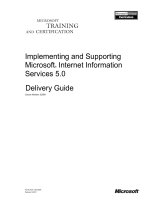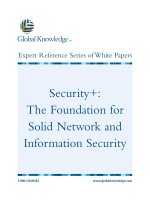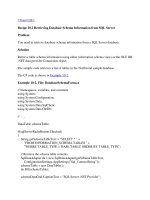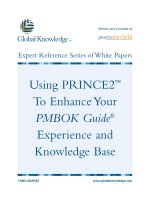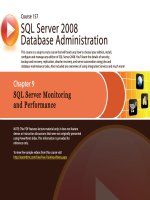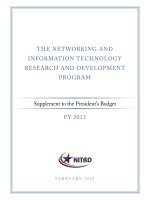Database Guide: Library and Information Science Abstracts (LISA) pptx
Bạn đang xem bản rút gọn của tài liệu. Xem và tải ngay bản đầy đủ của tài liệu tại đây (413.5 KB, 15 trang )
Database Guide:
Library and Information Science Abstracts (LISA)
©ProQuest http://pro quest.com/go/training
ProQuest training material – permission to copy Document update: 11 September 2009
Contents
What is Library and Information Science Abstracts (LISA)? 2
Subject Coverage 2
Selection Policy 2
Sample Record 3
Searchable Field Codes 4
Language 5
Boolean Operators and Other Search Tools Supported by the Illumina Interface 6
Quick, Advanced, or Command Searching 7
Limits 9
Sorting 10
Showing Records 10
Printing, Saving, and E-mailing Records 10
Thesaurus Search 11
Browse Indexes 13
The Research Process 13
Where to find help 15
Database Guide:
Library and Information Science Abstracts (LISA)
©ProQuest http://pro quest.com/go/training
ProQuest training material – permission to copy Document update: 11 September 2009
What is Library and Information Science Abstracts (LISA)?
LISA is an international abstracting and indexing service designed for library professionals and other
information specialists. LISA provides bibliographic information about past and present developments in
librarianship, information science, online retrieval, publishing and information technology. This database
covers around five hundred periodicals from over sixty countries. It also includes unpublished academic
and institutional research from the IRWI - Information Research Watch International database.
Subject Coverage
Library management
E-learning
The semantic web
Collection development
Knowledge management
Scholarly communication
Cataloguing and classification
Information literacy
Open access
Library technology
Freedom of information
Digital preservation
Information retrieval
Electronic publishing
Search engines
Digital libraries
E-government
Social inclusion
Evidence based librarianship
Taxonomies and ontologies
E-commerce
Copyright
Digital rights management
Consumer health information
Intelligence and national security
Professional development
Selection Policy
LISA has an international perspective, and a diverse audience including researchers, students, library
staff, and information professionals. Since its inception in 1969 LISA has been interested in a broad range
of library and information science (LIS) theory and practice, now taking in developments facilitated by
information and communications technology and LIS-related fields such as archives, records
management, publishing, information design and technical writing. Consequently, LISA covers a great
variety of publications.
In considering candidate journals at the scholarly end, the editor takes account of a range of standard
criteria, eg publishing standards, timeliness, editorial content, peer review, international diversity of
authorship and citation data. The editor also needs to have an eye for current trends and growth points
within the field - at the moment, for example, in developments in Web-based distance education and
electronic government. LISA is also interested in important but more topically-oriented journals and
magazines, such as the CILIP "Update" in the UK or "Bibliotecche Oggi" in Italy, and in smaller, more
limited publications which deal with specialist areas of interest to the library community (eg "The One
Person Library").
There are around 500 titles on Illumina, 26 of which are e-journals.
Database Guide:
Library and Information Science Abstracts (LISA)
©ProQuest http://pro quest.com/go/training
ProQuest training material – permission to copy Document update: 1 1 September 2009
For most of these journals, all articles are indexed and abstracted, but for a few fringe titles, the editor
selects only those relevant to the information community.
Around one third of current journals are published in the UK another third in the USA. The rest come from
a variety of countries including 14 titles from Germany, 12 from Japan, 6 from South Africa, 5 from
France, 4 from India.
For a complete current serials source list please go to:
Sample Record:
Database Guide:
Library and Information Science Abstracts (LISA)
©ProQuest http://pro quest.com/go/training
ProQuest training material – permission to copy Document update: 1 1 September 2009
Searchable Field Codes
Field Name
Label
Search Examples
Indexing Policy
Abstract
AB=
AB=library automation
50% of abstracts are written by the
indexers.
Author abstracts will be recognised by
the following at the end of the abstract
(author abstract)or (author abstract-
amended) or even (Quotes from
original text)
Accession
Number
AN=
AN= 337749
Accession number is the unique
number of the record in this particular
database
Author
AU=
AU=Corti, Louise,
AU= Goswami, P R
All Authors are indexed as they appear
in the journal
Descriptors
DE=
DE=Library Management
Descriptors are terms from the
thesaurus enriched by additional non-
thesaural terms. (See section on
thesaurus below)
Features
FE=
FE=refs
The feature describes extra
information that you will find in the
fulltext. It may inlcude one or more of
the following
il : Illustrations
ports: Portraits
refs: Cited references
maps: Maps
tbls: Tables
music: Music
ISBN
IB=
IB= 1873671318
This is the ISBN (International
Standard Book Number). This is the
unique number for a book
ISSN
IS=
IS= 0306-4573
An ISSN (International Standard Serial
Number). This is the unique number of
a journal.
Journal volume
JV=
JV=34
This is the Volume number of a
journal.
Journal Issue
JI=
JI=4
This relates to the issue number of a
journal.
Journal Name
JN=
JN=Information Today
This field is word indexed. This
Database Guide:
Library and Information Science Abstracts (LISA)
©ProQuest http://pro quest.com/go/training
ProQuest training material – permission to copy Document update: 1 1 September 2009
information is displayed under the
header called Source
Journal Page
JP=
JP=129
This will retrieve either the start page
or the end page of an article.
Keywords
KW=
KW=library management
The Keyword field is searching Title,
Abstracts and Descriptors fields
together. It is the best way to search
all the subject fields altogether.
Language
LA=
LA=French
See the section on language to see
which languages are covered in LISA
Publication Type
PT=
PT=Journal Article
LISA only contains Journal article,
Publication Year
PY=
PY=2003
Four digit numeral which describes the
year of publication of an item.
Resource
Location
RL=
RL=firstmonday
This contains the URL where the
document has been posted.
Shelfmark
SH=
SH=4496.373700
British Library shelfmark.
Very useful if you want to know where
to find an item within the British Library
Source
SO=
SO=Information today
near 21
This field contains the journal name
(JN), volume, issue, year and page
number. You can search all of the
above mentioned information using a
proximity operator.
Title
TI=
TI=fear factors
TI=La Bibliotheque
Orientale: histoire,
conservation et
numerisation. The
Bibliotheque Orientale:
history, conservation and
arrangement
The full title is found. If the article is
published in another language than
English, the original title will be
displayed first followed by a translation
in British English
Update
UD=
UD=200412
This is the date when the record was
uploaded to CSA Illumina.
YYYYMMDD
Language
Articles in any of the following languages are indexed in LISA:
Database Guide:
Library and Information Science Abstracts (LISA)
©ProQuest http://pro quest.com/go/training
ProQuest training material – permission to copy Document update: 1 1 September 2009
Afrikaans
English
Italian
Serbian
Arabic
Finnish
Japanese
Slovak
Bulgarian
French
Malay
Slovenian
Catalan
Gaelic
Norwegian
Spanish
Croatian
German
Persian
Swedish
Czech
Hebrew
Polish
Turkish
Chinese
Hungarian
Portuguese
Urdu
Danish
Icelandic
Rumanian
Yugoslav
Dutch
Indonesian
Russian
Welsh
Boolean Operators and Other Search Tools Supported by the Illumina Interface
Boolean operators help define the relationships between words or groups of words.
AND
Use to narrow a search and retrieve records containing all of the words it
separates
OR
Use to broaden a search and retrieve records containing any of the words it
separates
NOT
Use to narrow a search and retrieve records that do not contain the term following
it
( )
Use to group words or phrases when combining Boolean phrases and to show the
order in which relationships should be considered
Proximity operators identify the number of words to come between the search terms.
WITHIN "X"
Use to narrow a search by specifying a proximity relationship of fewer than “X”
words between search terms.
NEAR
Use to narrow a search by specifying a proximity relationship of fewer than 10
words between search terms
Special symbols can expand the scope of your search.
*
Truncate using the wild card symbol. This expands a search term to include forms
of a root word, e.g. catalog* retrieves catalog, catalogue, catalogs, catalogues,
cataloguing, etc.
?
Find alternative spellings. The ? represents any single character; ?? represents
two characters and so on. Use within or at the end of a word, e.g. wom?n finds
woman as well as women
Database Guide:
Library and Information Science Abstracts (LISA)
©ProQuest
ProQuest training material – permission to copy Document update: 11 Sept ember 2009
Note: Search queries containing several operators search in the following order: ( ), NEAR, NOT,
AND, OR
Quick, Advanced, or Command Searching
On Illumina, search strategies can be applied using one of three approaches.
Quick Search: Depending on the defaults set by your administrator, Quick Search either executes your
search “anywhere” or only searches “keywords”. An anywhere search looks across all of the available
fields in a record whereas a Keyword search would look in the subject fields (Title, abstracts, descriptors,
identifiers, Original titles).
Multiple words entered into the search field, will be treated as a phrase. Searches are not case sensitive.
Database Guide:
Library and Information Science Abstracts (LISA)
©ProQuest
ProQuest training material – permission to copy Document update: 11 Sept ember 2009
Advanced Search: Gives you the advantage of being able to select any of the 19 field codes from a pull-
down menu. The separate search boxes are formatted to include the Boolean Operators to help guide
you in formatting your search.
Database Guide:
Library and Information Science Abstracts (LISA)
©ProQuest
ProQuest training material – permission to copy Document update: 11 Sept ember 2009
Command Search or Professional Search: May be preferred by advanced users who are comfortable
with entering search strategies without the aid of a template.
Limits
Search strategies may be refined by using the following limits (available in „Advanced Search‟ and
„Command Search‟):
Latest Update limits your results to include only the most recent records that were added to the
database. LISA is updated twice monthly.
Journal Articles Only limits the search to only include the publication type of journal articles
English Only limits retrieval to only records that are available in English.
By Publication Date limits retrieval to a specific date range.
Database Guide:
Library and Information Science Abstracts (LISA)
©ProQuest
ProQuest training material – permission to copy Document update: 11 Sept ember 2009
Sorting
The sorting features give you the opportunity to order your results based on the publication date or
relevancy.
Most Recent First displays the records in order beginning with the most recent.
Relevance Rank displays records in order based on relevancy. Relevancy is determined through a rating
system that weighs the records based on the number of times the term(s) appear in the record and where
they appear.
Showing Records
Select how to display records from the „Show‟ pull-down menu. Options include displaying the short
format, full format, full format-no references, and custom format.
The „de-duplication‟ feature automatically removes any duplicate records that appear in your set of
results, which is especially useful when you are cross-database searching. You can also use the „Show
Duplicates‟ feature to display the duplicates.
When viewing records on Illumina, both the author and descriptors are hot linked. Clicking on the hot-link
will search the database for each occurrence of the selected author or descriptor.
Printing, Saving, and E-mailing Records
Printing, saving, and e-mailing records can be done by using the „Save, Print, E-mail‟ function. This
function also includes an exporting feature to a number of bibliographic managers such as RefWorks and
the use of our output format editor, QuikBib.
Database Guide:
Library and Information Science Abstracts (LISA)
©ProQuest
ProQuest training material – permission to copy Document update: 11 Sept ember 2009
Thesaurus Search
Using a thesaurus is a more powerful way to identify relevant descriptors, along with related terms.
The Thesaurus is a search aid that helps you select appropriate terms, ensuring the most comprehensive
retrieval. In LISA, the thesaurus allows you to browse terms in a hierarchical index and helps you define
more accurately what you are looking for.
LISA Thesaurus may be searched directly from the Thesaurus tab, using the Thesaurus Search Feature.
There are 3 ways of searching the thesaurus:
1. The Alphabetical display presents an alphabetical list of thesaurus terms. This can be compared
to an Index
2. The Hierarchical display shows a term and its hierarchy. You will find additional information in this
view, including its Scope and History Notes, any Use For (UF) or Use directions, and its
hierarchical relationships with Broader Terms (BT), Narrower Terms (NT), and Related Terms
(RT). (see screenshot below)
3. The Rotated Index displays all thesaurus terms or phrases that contain the search term used.
You should only enter one word in the box. For example if you search for the word “libraries” you
will display libraries as a descriptor term but also “Academic libraries”, “Digital libraries” etc.
This example illustrates the hierarchical display:
Database Guide:
Library and Information Science Abstracts (LISA)
©ProQuest
ProQuest training material – permission to copy Document update: 11 Sept ember 2009
"Online catalogues" may be referred to in English language documents by a number of terms, such as:
- online catalogs
- online public access catalogues
- OPAC
- OPACs
The LISA Thesaurus gives one permitted term or descriptor and that is "Online catalogues". The other
synonymous terms are listed in the Thesaurus, with a UF (Used For) reference to the permitted term.
Descriptor (DE): Online catalogues
Used For: Online catalogues, Online public access catalogues, OPAC, OPACs
Broader term BT: Catalogues
Narrower Terms NT Online union catalogues
Related Terms RT: Computerized catalogues, Online cataloguing
Marked terms can be searched from any of the displays, applying AND, OR, or Explode operators, and
setting limits as defined above.
Database Guide:
Library and Information Science Abstracts (LISA)
©ProQuest
ProQuest training material – permission to copy Document update: 11 Sept ember 2009
Browse Indexes
Searches may also be activated through three browsable indexes: Author, Journal Name, and Publication
Type.
The Research Process
I. How to begin the electronic research process
A. Determine your goals:
1. State your research question: “??”
2. Set parameters for your search (eg, technology type, gender, geographical location)
B. Identify general concepts:
1. Which general terms relate to your search?
C. Choose the appropriate database:
1. Are there specific journals that specialize in your area of research?
II. Build your search strategy
A. Quick Search:
Database Guide:
Library and Information Science Abstracts (LISA)
©ProQuest
ProQuest training material – permission to copy Document update: 11 Sept ember 2009
1. Enter phrase or multiple search terms separated by Boolean operators AND to
link terms, OR to link similar words or synonyms in the Quick Search box.
B. Advanced Search:
1. The drop boxes allow you to limit the search by any of the searchable field codes
including Keyword (KW), Author (AU), Journal Name (JN), Descriptor (DE), Abstract
(AB), or Title (TI).
2. You can also limit your search to specific publication years and choose the record
format.
3. The descriptor field (DE) and abstract field (AB) will allow you to narrow down your
search even more by locating specific descriptors and key words in the abstract.
Example: If I wanted to limit my search to India.
III. Analyzing Results
A. Good results:
1. If results are satisfactory, then Save, Print, E-mail citations or download them to a
bibliographic manager such as RefWorks or QuikBib.
B. If results are not on target:
1. Check spelling of search terms and use thesauri or browsable indexes to drop
unnecessary or misleading terms.
2. Increase precision: for example, if you want to emphasize the gender gap in access to
Internet, then you may have to search access as a descriptor (DE) or word in the title of
the article instead of by keyword (KW). Also, sexual inequality may be more specific than
just sex difference.
3. You may need to rethink whether the database you selected is appropriate for your
search.
C. Too few or too many results:
1. Increase retrieval by using fewer ANDs and more Ors.
Example: KW=Internet OR information technology OR computers
2. Increase precision by using additional ANDs and fewer ORs (NOT can be used to
exclude some terms)
Example: KW=(Internet AND information technology AND computers NOT
telecommunications
Database Guide:
Library and Information Science Abstracts (LISA)
©ProQuest
ProQuest training material – permission to copy Document update: 11 Sept ember 2009
Where to find help
Search our Support Center:
To access product help and training documentation:
By phone
In North America: 800-889-3358
Outside North America: 0880 220 710 (UK only)
+44 1223 271 496 (Outside of UK)
